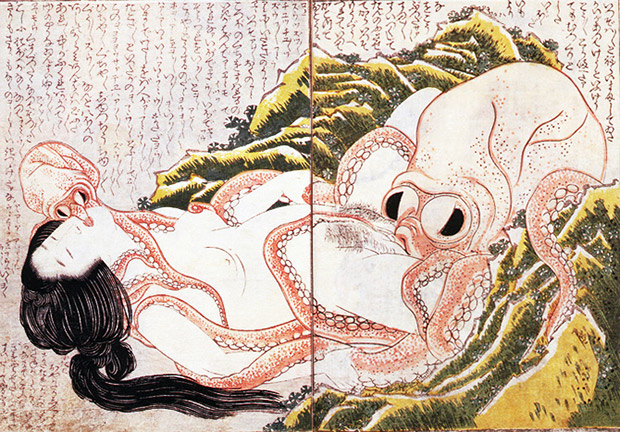Japanese “manga” has many subcategories. There’s a wide variety of mainstream manga, but it can also veer off to darker places. Loli and shota illustrate underage characters, guro and vore are extremely violent and can include snuff, and hentai quite often shows consensual and non-consensual BDSM.
It’s not hard to find any of those varieties on the internet, and you’ll notice that boydenon and I quite often use manga to illustrate our articles.
The way some manga characters are drawn can cause Westerners to view them as underaged, though the Japanese see a clear distinction between manga and loli/shota. Some artists draw submissive characters with big eyes, small bodies and no body hair, making them appear child-like.
But, it’s not age that’s being illustrated, it’s innocence and power. Powerful characters are bigger, hairier and often clothed. Less powerful characters are smaller, weaker and “child-like”. It’s symbolic shorthand in the art, allowing quick visual reading of the character and their role.
A HISTORY OF SEX AND PLEASURE

Traditions of sex in art goes back a long way in Japan. If you’ve seen Katsushika Hokusai’s 1814 picture The Dream of the Fisherman’s Wife then you’ve seen one of thousands of paintings in a category known as shunga. Shunga dates as far back as the Edo period (from the early 1700s) and continued all the way through the Meiji period, but there are humorous pornographic images in Japanese museums that date back to the 12th century.
It is one of the most salacious images in the history of art: deep underwater, a gigantic pink octopus drags a naked young woman into a cleft between two rocks. As his coiling tentacles slither over her blemish-free body, caressing a nipple and encircling her nubile legs, this unlikely molluscoid lover pleasures his prostrate captive, who throws back her head in ecstasy while a second, smaller octopus plants a tender kiss upon her mouth.
BBC Culture
Shunga is often translated to “pillow pictures”, but the Japanese word also encompasses “humour”, and although they were explicit, they were often funny too.
Perhaps one way to understand the exaggeration and symbolism that modern manga uses is through this quote from Tachibana no Kagesue in 1254, regarding why it is that artists of “pillow pictures” tended to paint both men and women with exaggerated genitals:
The old masters… depict the size of “the thing” far too large… If it were depicted the actual size there would be nothing of interest. For that reason, don’t we say “art is fantasy”?
TELLING DIRTY STORIES
Even manga comics have a rich history. The word itself comes from Hokusai, and it has existed from the 1800s. It really took off in the 1950s, and that marks a kind of transition from pre-manga generation to manga generation. Along with an explosion in family friendly themes for men and women, such as Osamu Tezuka’s Astro Boy, the shunga tradition morphed into “hentai seiyoku”, which included fetishism and gay themes (yaoi/yuri).
In the West we probably would have tightly restricted the sale of hentai and hid it behind closed doors, but Japanese didn’t see it in the same prudish way, and it’s common to hear stories from travellers to Japan of their shock when they look over the shoulder of the passenger next to them on the train and glimpse what they’re reading.
But, our Western ideas of morality have led to global pressure on Japan. Although there have been laws in place in Japan for 15 years banning the creation of pornographic images of children, it was only in 2014 that possession of this kind of (photographic) material was banned, and the new laws do not include illustration.
Experts don’t find this as clear cut as you would think, and this interview (embedded below) with Tim Pilcher – the author of “Erotic Comics: a Graphic History” and chairman of the Comic Book Alliance, Akemi Solloway – a lecturer and teacher of Japanese culture and language, and Bharti Patel, from the organisation “End Child Prostitution, Child Pornography And Trafficking of Children for Sexual Purposes” discusses some of the issues.
FURTHER READING
• BBC Culture – Sexually Explicit Japanese Art Challenges Western Ideas
• Matt Thorne – The History of Manga
• Timothy Clark (YouTube) – Shunga: Sex and Pleasure in Japanese Art
• The Guardian – Does Japanese Shunga turn Porn into Art?
• Wikipedia – Hentai
• Elephant Journal – Ancient Pervy Japanese Porn. I Mean, Art. (Shunga)
